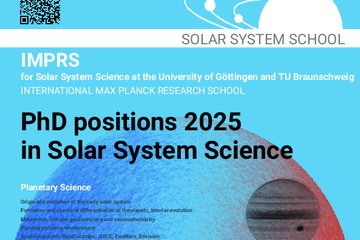All genres
61.
Journal Article
Preparation for the solar system observations with Herschel: Simulation of Jupiter observations with PACS. Planetary and Space Science 58 (13), pp. 1692 - 1698 (2010)
62.
Journal Article
The Herschel-SPIRE submillimetre spectrum of Mars. Astronomy and Astrophysics 518, L151 (2010)
63.
Journal Article
Water and related chemistry in the solar system. A guaranteed time key programme for Herschel. Planetary and Space Science 57, pp. 1596 - 1606 (2009)
64.
Journal Article
Triple F-a comet nucleus sample return mission. Experimental Astronomy 23, pp. 809 - 847 (2009)
65.
Journal Article
Triple F—a comet nucleus sample return mission. Experimental Astronomy 23 (3), pp. 809 - 847 (2009)
66.
Journal Article
TNOs are Cool: A Survey of the Transneptunian Region. Earth, Moon and Planets 105, pp. 209 - 219 (2009)
67.
Journal Article
HHSMT observations of the Venusian mesospheric temperature, winds, and CO abundance around the MESSENGER flyby. Planetary and Space Science 56, pp. 1688 - 1695 (2008)
68.
Journal Article
Mesospheric vertical thermal structure and winds on Venus from HHSMT CO spectral-line observations. Planetary and Space Science 56, pp. 1368 - 1384 (2008)
69.
Journal Article
Observations of Comet 9P/Tempel 1 around the Deep Impact event by the OSIRIS cameras onboard Rosetta. Icarus 187, pp. 87 - 103 (2007)
70.
Journal Article
Gas and Dust Condensations and a Peculiar Class 0 Object in the Lupus 3 Star-Forming Cloud. Astrophysical Journal 659, pp. 1382 - 1393 (2007)
71.
Journal Article
Discovery of the Optical Transient of GRB 990308. Astrophysical Journal 524, p. 103 (1999)
72.
Book Chapter
5 - Atmospheric circulation and dynamics - Observations and knowledge gaps. In: Towards understanding the climate of Venus: Applications of terrestrial models to our sister planet, pp. 55 - 72 (Eds. Bengtsson, L.; Bonnet, R.-M.; Grinspoon, D.; Koumoutsaris, S.; Lebonnois, S. et al.). Springer-Verlag, Berlin (2012)
73.
Book Chapter
Retrieval Simulations of Atmospheric Gases from Herschel observations of Titan. In: Advances in Geosciences, pp. 335 - 348 (Eds. Bhardwaj, A.; Haider, S. A.; Hartogh, P.; Ip, W.-H.; Ito, T. et al.). World Scientific Publishing Co., Singapore (2011)
74.
Book Chapter
Modeling of the Terminal Velocities of the Dust Ejected Material by the Impact. In: Deep Impact as a World Observatory Event - Synergies in Space, Time (Eds. Kaeufl, H. U.; Sterken, C.). Springer Verlag (2007)
75.
Proceedings
Laboratory Astrophysics Data Working Group IAU 2022 GA session. IAU Symposium, 2024. (2024), 43-48 pp.
76.
Proceedings
About the atomic and molecular databases in the planetary community - A contribution in the Laboratory Astrophysics Data WG IAU 2022 GA session. IAU Symposium, 2024. (2024), 87-91 pp.
77.
Conference Paper
The volatile composition of comet C/2004 Q2 (Machholz) derived from submillimeter observations. In: Highlights of Spanish Astrophysics VII, Proceedings of the X Scientific Meeting of the Spanish Astronomical Society (SEA) (Eds. Guirado, J. C.; Lara, L. M.; Quilis, V.; Gorgas, J.). (2013)
78.
Conference Paper
Observations of Comet 9P/Tempel 1 and Deep Impact by the OSIRIS Cameras onboard Rosetta. In: Deep Impact as a World Observatory Event: Synergies in Space, Time, and Wavelength, pp. 29 - 39. Springer Berlin / Heidelberg (2009)
79.
Conference Paper
Modeling of the Terminal Velocities of the Dust Ejected Material by the Impact. In: Deep Impact as a World Observatory Event: Synergies in Space, Time, and Wavelength, pp. 137 - 142. Springer Berlin / Heidelberg (2009)
80.
Conference Paper
The terminal Velocity of the Deep Impact dust Ejecta. In: Revista Mexicana de Astronomía y Astrofísica (SC)., pp. 25 - 26 (Eds. Magris, G.; Bruzual, G.; Carigi, L.). (2009)











